
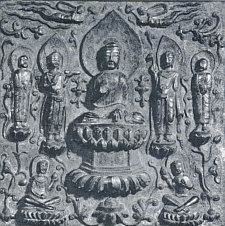
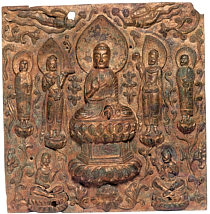
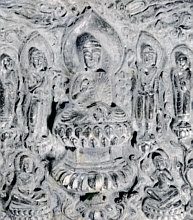
In ancient 6-9th centuries Far-EAST, Embossed bronze buddhist images
were popular, which was beaten on concave/convex bronze mould.
Usually, they were embellished by engraving and gilting.
It should have been cheap, because many products can be made with one mold
and it doesn't need much bronze.
Mounted to wood/metal frame, it became personal worship image, or
Put many plaques to wall of alter/temple, which they ornamented.
Most plaques have several nail holes. It suggest their usage.
Horyu-ji monastery in Japan has some
backing wood and bronze plate for such embossed images
In Japan, Horyu-ji monastery and relative temples and museums have
several 7th century plaques.
Japanese learned such technique from China, but chinese embossed plaques are
rare.
They should have been more producted than casted whole images, so more should
have survived. Controversely, a plaque is rare than a whole images.
I feel strange.
They were not carefully handled as whole cast image?
This thin plate might call heavy corrosion anf bronze desease?
Because they were wall ornaments, they disapeared with the architecture?
Here, I introduce some chinese plaques.
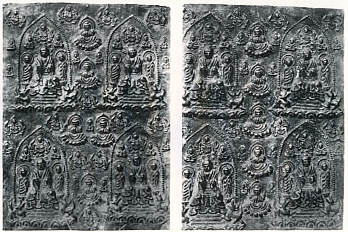 Perhaps, this plaque is the oldest. Maybe middle 6th century.
[Enlarged]
The drapery pattern of lower part of buddha robes were popular in middle
6th century.
I feel some possiblity that it was made in Korea, but I think it be mostly
chinese.
Their rows of triads clearly show that they were ornaments of wall.
Under the throne, two animals admired. They feel deers. If it so,
it is a Shakayamuni-buddha Paradise, because deers symborized
Sarnat( Deer Garden) where Shakayamuni-buddha first teached.
Perhaps, this plaque is the oldest. Maybe middle 6th century.
[Enlarged]
The drapery pattern of lower part of buddha robes were popular in middle
6th century.
I feel some possiblity that it was made in Korea, but I think it be mostly
chinese.
Their rows of triads clearly show that they were ornaments of wall.
Under the throne, two animals admired. They feel deers. If it so,
it is a Shakayamuni-buddha Paradise, because deers symborized
Sarnat( Deer Garden) where Shakayamuni-buddha first teached.

|

|

|

|
1st upper Left is Hosokowa Collection plaque(h 15.4 x w 15.2cm) [Enlarged] ÅE In 1930s, several similar plaques should been uneathed at the same site. Three other palaques were published. 2nd(monocrome) in Winthlop collection, Harvard Univ.(Cat. No.1943.53.74) [Enlarged] ÅE, 3rd(colour) in MOA Museum, Japan, [Enlarged] ÅE, 4th(monochrome) in Hakuturu Museum, Japan. They were made with the same mold, but additive engraving and incising made some varinations. Corrosion, damage, and patina change the surface.
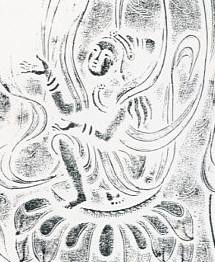 These are thought to be 6-7th century.
The slender bodies of lower boddhisatvas on lotus thrones like
7th century Japan casted relief bronze screen plate in Horyu-ji, Nara.
Perpendicular bodies of attendants like ones in the Alterpiese(AD593
:Sui Dynasty), which is in Fine Arts Museum, Boston.
Date of these 4 plaques should be Sui-early Tang dynasty.
These are thought to be 6-7th century.
The slender bodies of lower boddhisatvas on lotus thrones like
7th century Japan casted relief bronze screen plate in Horyu-ji, Nara.
Perpendicular bodies of attendants like ones in the Alterpiese(AD593
:Sui Dynasty), which is in Fine Arts Museum, Boston.
Date of these 4 plaques should be Sui-early Tang dynasty.
What is the name of this buddha? Left attendant bodhisatvas holds
an indian book. Such book is a sign of Manjusili Bodhisattvas.
Since Manjusili Bodhisattovas is usually an attendant of Shakyamuni Buddha,
this plaque should depict Syakyamuni Buddha Paradise.
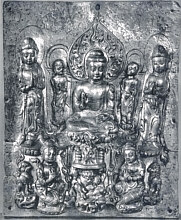
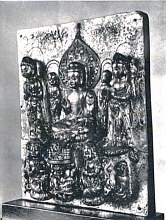 It might not be believable that this be an embossed plaque.
[Enlarged]
22.4x 18.8cm. At heighest, it is raised up 5cm ( 6cm thick, ca).The parfume burner a monster supports raised than others. It likes that
whole images casted should be attouched to a bronze plate. But it is really
an embossed plate beaten of a bronze plate.
[3/4 angle Enlarged IMAGE]
Since back beaten hollow is wide at bottom, it was not beaten on mold.
Supporting a bronze plate with a sort of paste, craftmen should beat.
It might not be believable that this be an embossed plaque.
[Enlarged]
22.4x 18.8cm. At heighest, it is raised up 5cm ( 6cm thick, ca).The parfume burner a monster supports raised than others. It likes that
whole images casted should be attouched to a bronze plate. But it is really
an embossed plate beaten of a bronze plate.
[3/4 angle Enlarged IMAGE]
Since back beaten hollow is wide at bottom, it was not beaten on mold.
Supporting a bronze plate with a sort of paste, craftmen should beat.
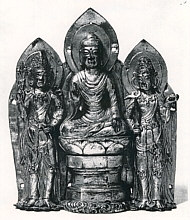 This date is uncertain , may be after late Tang dynasty.
[Enlarged]
Indeed it is a real chinese embossed plaque, it is not refined,
somewhat intimate, and a little lamaistic.
The left attendant has a sword and a square object ( Indian book??).
This is an esoteric icon of Manjusili. Hence it must be after later
8th century.
This date is uncertain , may be after late Tang dynasty.
[Enlarged]
Indeed it is a real chinese embossed plaque, it is not refined,
somewhat intimate, and a little lamaistic.
The left attendant has a sword and a square object ( Indian book??).
This is an esoteric icon of Manjusili. Hence it must be after later
8th century.